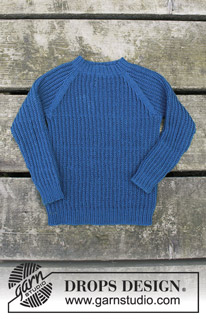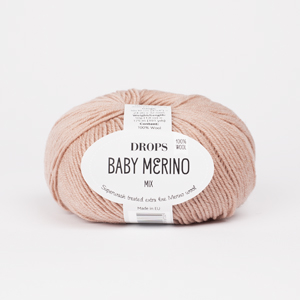Comments / Questions (128)
![]() Mieke wrote:
Mieke wrote:
Wat wordt bedoeld bij raglan breien \" om de andere naald\"?. Is dat 1 naald minderen ; naald 2 gewoon breien en naald 3 weer minderen? \r\nErgo, de oneven naalden minderen?
11.06.2025 - 11:49
![]() Halina wrote:
Halina wrote:
Bei der Anleitung steht nicht wann ich für Halsausschnitt abnehmen soll ab wie viel cm in der Mitte und wie viel in der Mitte abnehmen und seitlich eine rund Hals machen bin am blättern und lesen 📖 finde ich nichts auch bei der Zeichnung sind keine cm angegeben??
10.06.2025 - 20:43DROPS Design answered:
Liebe Halina, es gibt keine besondere Abnahmen für Halsausschnitt, dh Halsausschnitt wird gleich vorne und hinten sein. Wenn alle Raglan-Abnahmen fertig sind, Stricken Sie die Passe über die restlichen Maschen. Viel Spaß beim Stricken!
11.06.2025 - 08:06
![]() Nena wrote:
Nena wrote:
Er det en bestemt måte å måle bredden på genseren? Jeg har strikket kun 6 cm på bolen og synes at den kan strekke seg mye. Takk for hjelpen.
05.06.2025 - 12:14DROPS Design answered:
Hei Nena. Patent strekker seg veldig, bare pass på å overholde den oppgitte strikkefastheten. Ville ha lagt plagget flatt når det skal måles. mvh DROPS Design
10.06.2025 - 13:18
![]() Ana wrote:
Ana wrote:
Cómo se teje el Falso Punto Inglés en redondo con agujas de alambre?
24.04.2025 - 22:16DROPS Design answered:
Hola Ana, puedes ver en este video cómo se trabaja el falso punto inglés en redondo con agujas circulares.
26.04.2025 - 20:42
![]() Loredana wrote:
Loredana wrote:
Buongiorno, volendo lavorare un'alzatina per il collo posteriore, come mi devo regolare? Grazie
19.02.2025 - 08:45DROPS Design answered:
Buonasera Loredana, per un'assistenza così personalizzata può rivolgersi al suo rivenditore DROPS di fiducia. Buon lavoro!
23.02.2025 - 23:56
![]() Astrid Arntsen wrote:
Astrid Arntsen wrote:
Kan ikke finne noen forklaring på felling til hals…..Er den der, bare jeg som ikke ser den?
14.02.2025 - 13:08DROPS Design answered:
Hej Astrid, HALSKANT: Bytt til rundpinne 2,5. Strikk 1 RILLE rundt over alle maskene, SAMTIDIG på første omgang i rillen felles det 19-17-13-11-6-7 masker jevnt fordelt – les FELLETIPS = 81-87-93-99-102-105 masker. Strikk vrangbord (= 1 rett / 2 vrang) i 3 cm, deretter felles det av med rett over rett og vrang over vrang.
18.02.2025 - 10:13
![]() Oddny Helene Tomren wrote:
Oddny Helene Tomren wrote:
Hvor finner jeg diagram for patentstrikk i denne oppskriften ?
14.01.2025 - 17:52DROPS Design answered:
Hej, nederst i opskriften til højre for måleskitsen finder du diagrammet :)
15.01.2025 - 07:47
![]() Oddny Helene Tomren wrote:
Oddny Helene Tomren wrote:
Hvor finner jeg diagram for patentstrikk i denne oppskriften ?
14.01.2025 - 17:40
![]() Eva wrote:
Eva wrote:
Jag stickar strl 3 år.
14.01.2025 - 16:06
![]() Eva wrote:
Eva wrote:
Jag har valt att inte sticka på rundsticka utan på vanliga stickor till strl 3. Jag har lagt upp 84 maskor och stickat upp till ärmhålen som möter 23 cm, maskar av 4 msk i var sida och maskar för raglan 1 msk varannat varv i varje sida (2 msk på varvet)\r\nÄrmhålet verkar bli för litet. Hur kan hela tröjan vara 40 cm nerifrån upp till axeln då arbetet upp till ärmhålet är 23 cm, skulle ärmhålet vara 17 cm? Vad har jag gjort för fel?
12.01.2025 - 19:50DROPS Design answered:
Hej Eva, hvis du holder strikkefastheden med 32 pinde på 10 cm i højden, så bliver ærmegabet 15 cm + de første 2 cm = 17 cm (48 pinde/3,2=15 cm). Hvis du strikker strammere end vi gør i opskriften, kan du strikke 1 pind mere mellem hver indtagning, så du tager ind på hver 3.pind (istedet for hver 2. pind)!
14.01.2025 - 14:28
Perkins#perkinssweater |
||||||||||
 |
 |
|||||||||
Knitted jumper with false Fisherman’s rib and raglan for kids in DROPS BabyMerino or DROPS Safran. Size 2 - 12 years.
DROPS Children 30-9 |
||||||||||
|
INFORMATION FOR PATTERN: GARTER STITCH (worked in the round): 1 ridge = 2 rounds. Knit 1 round and purl 1 round. PATTERN: See diagram A.1. INCREASE TIP: Work until 1 stitch remains before marker thread. Make 1 yarn over, purl 2 (marker is between these 2 stitches), make 1 yarn over (= 2 stitches increased). On next round work yarn overs twisted to avoid holes. Work the increased stitches in A.1 and purl the 2 stitches at the marker thread. RAGLAN: Decrease for raglan in every transition between sleeves and body. Begin 3 stitches before marker thread and knit 2 together, knit 2 (marker thread is between these 2 stitches), slip 1 stitch knitwise, knit 1, pass slipped stitch over stitch worked (= 2 stitches decreased). DECREASE TIP: To calculate how to decrease evenly, use the total number of stitches on round (e.g. 100 stitches) and divide stitches by number of decreases to be done (e.g. 19) = 5.3. In this example knit approx. every 4th and 5th stitch together. ---------------------------------------------------------- JUMPER: Worked in the round on circular needle. BODY: Cast on 156-168-174-186-192-204 stitches on circular needle size 2.5 mm with Baby Merino or Safran. Knit 1 round, then work rib as follows: purl 1, * knit 1, purl 2 *, repeat from *-* until 2 stitches remain on round, finish with knit 1 and purl 1. Continue rib like this for 4 cm. Switch to circular needle size 3 mm and work A.1 in the round over all stitches. REMEMBER THE KNITTING TENSION! When piece measures 20-23-26-29-32-35 cm, work next round as follows: Cast off 4 stitches for armhole, work 70-76-79-85-88-94 stitches (= front piece), cast off 8 stitches for armhole, work 70-76-79-85-88-94 stitches (= back piece) and cast off the last 4 stitches on needle for armhole. Put piece aside and work the sleeves. SLEEVE: Work in the round on double pointed needles/a short circular needle. Cast on 42-42-42-48-48-48 stitches on double pointed needles size 2.5 mm with Baby Merino or Safran. Knit 1 round, then work rib as follows: purl 1, * knit 1, purl 2 *, repeat from *-* until 2 stitches remain on round, finish with knit 1 and purl 1. Continue rib like this for 4 cm. Switch to double pointed needles size 3 mm and work A.1 in the round over all stitches. Insert 1 marker thread at beginning of round (= mid under sleeve). When piece measures 6 cm, increase 1 stitch on each side of marker thread - read INCREASE TIP! Repeat increase every 2½-2½-2½-3-3-2½ cm 7-9-10-9-11-13 times in total = 56-60-62-66-70-74 stitches. When piece measures approx. 23-28-31-35-39-42 cm (adjust to finish on same round in A.1 as on body), cast off 8 stitches mid under sleeve (cast off 4 stitches on each side of marker thread) = 48-52-54-58-62-66 stitches. Put piece aside and knit another sleeve. YOKE: Slip sleeves on to same circular needle as body where armholes were cast off (without working the stitches first) = 236-256-266-286-300-320 stitches on needle. Insert 1 marker thread in all transitions between sleeves and body piece (= 4 marker threads). RAGLAN: Continue pattern in the round as before. Work in the round over all stitches for 2 cm. On next round decrease for RAGLAN – see explanation above (= 8 stitches decreased). Continue decrease for raglan every other round until decrease has been done 17-19-20-22-24-26 times in total on each side of all marker threads. After all decreases for raglan there are 100-104-106-110-108-112 stitches on needle and piece measures approx. 36-40-44-48-52-56 cm up to shoulder. NECK EDGE: Switch to circular needle size 2.5 mm. Work 1 ridge in GARTER STITCH in the round over all stitches, AT THE SAME TIME on first round in ridge decrease 19-17-13-11-6-7 stitches evenly – read DECREASE TIP = 81-87-93-99-102-105 stitches. Work rib = knit 1/purl 2 for 3 cm, then cast off with knit over knit and purl over purl. ASSEMBLY: Sew the openings under the sleeves. |
||||||||||
Diagram explanations |
||||||||||
|
||||||||||

|
||||||||||
Have you finished this pattern?Tag your pictures with #dropspattern #perkinssweater or submit them to the #dropsfan gallery. Do you need help with this pattern?You'll find 25 tutorial videos, a Comments/Questions area and more by visiting the pattern on garnstudio.com. © 1982-2025 DROPS Design A/S. We reserve all rights. This document, including all its sub-sections, has copyrights. Read more about what you can do with our patterns at the bottom of each pattern on our site. |
||||||||||


































































Post a comment to pattern DROPS Children 30-9
We would love to hear what you have to say about this pattern!
If you want to leave a question, please make sure you select the correct category in the form below, to speed up the answering process. Required fields are marked *.